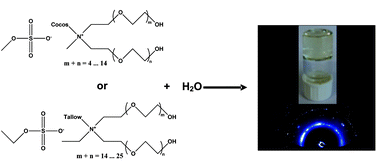Amphiphilic oligoether-based ionic liquids as functional materials for thermoresponsive ion gels with tunable properties via aqueous gelation†
Abstract
The aqueous

* Corresponding authors
a Laboratory of Macromolecular Chemistry and Nanoscience, Eindhoven University of Technology, PO Box 513, Eindhoven, The Netherlands
b
Ioniqa Technologies, Horsten 1, Eindhoven, The Netherlands
E-mail:
c.guerrero@ioniqa.com
Web: http://www.ioniqa.com
c Dutch Polymer Institute (DPI), PO Box 902, Eindhoven, The Netherlands
d CSIRO, Materials Science and Engineering Division, Bag 10, Clayton South MDC, Victoria, Australia
e
Laboratory of Organic and Macromolecular Chemistry (IOMC) and Jena Center for Soft Matter (JCSM), Friedrich-Schiller-University Jena, Humboldtstr. 10, Jena, Germany
E-mail:
ulrich.schubert@uni-jena.de
Web: http://www.schubert-group.com
The aqueous

 Please wait while we load your content...
Something went wrong. Try again?
Please wait while we load your content...
Something went wrong. Try again?
J. C. Ribot, C. Guerrero-Sanchez, T. L. Greaves, D. F. Kennedy, R. Hoogenboom and U. S. Schubert, Soft Matter, 2012, 8, 1025 DOI: 10.1039/C1SM06468A
To request permission to reproduce material from this article, please go to the Copyright Clearance Center request page.
If you are an author contributing to an RSC publication, you do not need to request permission provided correct acknowledgement is given.
If you are the author of this article, you do not need to request permission to reproduce figures and diagrams provided correct acknowledgement is given. If you want to reproduce the whole article in a third-party publication (excluding your thesis/dissertation for which permission is not required) please go to the Copyright Clearance Center request page.
Read more about how to correctly acknowledge RSC content.
 Fetching data from CrossRef.
Fetching data from CrossRef.
This may take some time to load.
Loading related content
